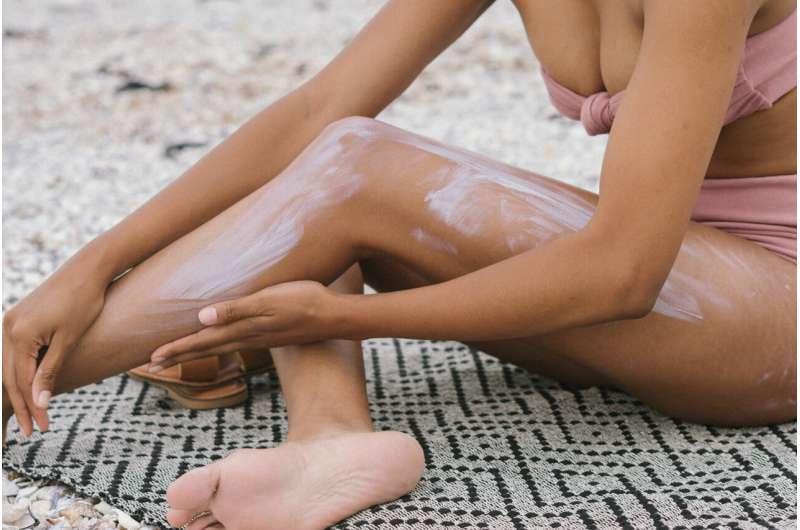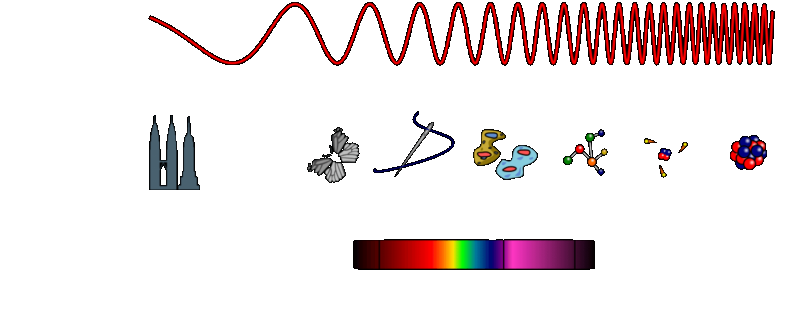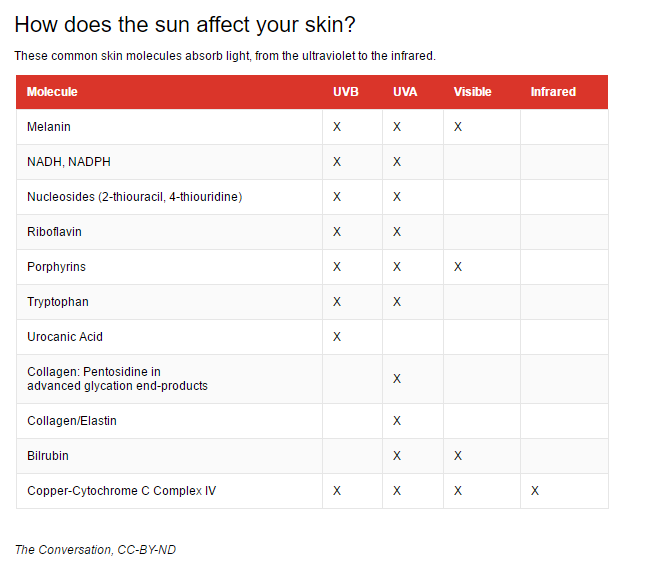Credit: RF._.studio from Pexels
Not so long ago, people like my Aunt Muriel thought of sunburn as a necessary evil on the way to a "good base tan." She used to slather on the baby oil while using a large reflector to bake away. Aunt Muriel's mantra when the inevitable burn and peel appeared: Beauty has its price.
Was she ever right about that price – but it was a lot higher than any of us at the time recognized. What sun addicts didn't know then was that we were setting our skin up for damage to its structural proteins and DNA. Hello, wrinkles, liver spots and cancers. No matter where your complexion falls on the Fitzpatrick Skin Type scale, ultraviolet radiation (UV) from the sun or tanning beds will damage your skin.
Today, recognition of the risks posed by UV rays has motivated scientists, myself included, to study what's going on in our cells when they're in the sun – and devise modern ways to ward off that damage.
What happens when sun hits skin
Sunlight is composed of packets of energy called photons. The visible colors we can see by eye are relatively harmless to our skin; it's the sun's ultraviolet (UV) light photons that can cause skin damage. UV light can be broken down into two categories: UVA (in the wavelength range 320-400 nanometers) and UVB (in the wavelength range 280–320 nm).
Our skin contains molecules that are perfectly structured to absorb the energy of UVA and UVB photons. This puts the molecule into an energetically excited state. And as the saying goes, what goes up must come down. In order to release their acquired energy, these molecules undergo chemical reactions – and in the skin that means there are biological consequences.
UV light that affects our skin has a shorter wavelength than the parts of the electromagnetic spectrum we can see. Credit: Inductiveload, NASA, CC BY-SA
Interestingly, some of these effects used to be considered helpful adaptations – though we now recognize them as forms of damage. Tanning is due to the production of extra melanin pigment induced by UVA rays. Exposure to the sun also turns on the skin's natural antioxidant network, which deactivates highly destructive reactive oxygen species (ROS) and free radicals; if left unchecked, these can cause cellular damage and oxidative stress within the skin.
We also know that UVA light penetrates deeper into the skin than UVB, destroying a structural protein called collagen. As collagen degrades, our skin loses its elasticity and smoothness, leading to wrinkles. UVA is responsible for many of the visible signs of aging, while UVB light is considered the primary source of sunburn. Think "A" for aging and "B" for burning.
DNA itself can absorb both UVA and UVB rays, causing mutations which, if unrepaired, can lead to non-melanoma (basal cell carcinoma, squamous cell carcinoma) or melanoma skin cancers. Other skin molecules pass absorbed UV energy on to those highly reactive ROS and free radicals. The resulting oxidative stress can overload the skin's built-in antioxidant network and cause cellular damage. ROS can react with DNA, forming mutations, and with collagen, leading to wrinkles. They can also interrupt cell signaling pathways and gene expression.
The end result of all of these photoreactions is photodamage that accumulates over the course of a lifetime from repeated exposure. And – this cannot be emphasized enough – this applies to all skin types, from Type I (like Nicole Kidman) to Type VI (like Jennifer Hudson). Regardless of how much melanin we have in our skin, we can develop UV-induced skin cancers and we will all eventually see the signs of photo-induced aging in the mirror.
Filtering photons before the damage is done
The good news, of course, is that the risk of skin cancer and the visible signs of aging can be minimized by preventing overexposure to UV radiation. When you can't avoid the sun altogether, today's sunscreens have got your back (and all the rest of your skin too).
Sunscreens employ UV filters: molecules specifically designed to help reduce the amount of UV rays that reach through the skin surface. A film of these molecules forms a protective barrier either absorbing (chemical filters) or reflecting (physical blockers) UV photons before they can be absorbed by our DNA and other reactive molecules deeper in the skin.
In the United States, the Food and Drug Administration regulates sunscreens as drugs. Because we were historically most concerned with protecting against sunburn, 14 molecules that block sunburn-inducing UVB rays are approved for use. That we have just two UVA-blocking molecules available in the United States – avobenzone, a chemical filter; and zinc oxide, a physical blocker – is a testament to our more recent understanding that UVA causes trouble, not just tans.
The FDA also has enacted strict labeling requirements – most obviously about SPF (sun protection factor). On labels since 1971, SPF represents the relative time it takes for an individual to get sunburned by UVB radiation. For example, if it takes 10 minutes typically to burn, then, if used correctly, an SPF 30 sunscreen should provide 30 times that – 300 minutes of protection before sunburn.
"Used correctly" is the key phrase. Research shows that it takes about one ounce, or basically a shot glass-sized amount of sunscreen, to cover the exposed areas of the average adult body, and a nickel-sized amount for the face and neck (more or less, depending on your body size). The majority of people apply between a quarter to a half of the recommended amounts, placing their skin at risk for sunburn and photodamage.
In addition, sunscreen efficacy decreases in the water or with sweating. To help consumers, FDA now requires sunscreens labeled "water-resistant" or "very water-resistant" to last up to 40 minutes or 80 minutes, respectively, in the water, and the American Academy of Dermatology and other medical professional groups recommend reapplication immediately after any water sports. The general rule of thumb is to reapply about every two hours and certainly after water sports or sweating.
To get high SPF values, multiple UVB UV filters are combined into a formulation based upon safety standards set by the FDA. However, the SPF doesn't account for UVA protection. For a sunscreen to make a claim as having UVA and UVB protection and be labeled "Broad Spectrum," it must pass FDA's Broad Spectrum Test, where the sunscreen is hit with a large does of UVB and UVA light before its effectiveness is tested.
This pre-irradiation step was established in FDA's 2012 sunscreen labeling rules and acknowledges something significant about UV-filters: some can be photolabile, meaning they can degrade under UV irradiation. The most famous example may be PABA. This UVB-absorbing molecule is rarely used in sunscreens today because it forms photoproducts that elicit an allergic reaction in some people.
But the Broad Spectrum Test really came into effect only once the UVA-absorbing molecule avobenzone came onto the market. Avobenzone can interact with octinoxate, a strong and widely used UVB absorber, in a way that makes avobenzone less effective against UVA photons. The UVB filter octocrylene, on the other hand, helps stabilize avobenzone so it lasts longer in its UVA-absorbing form. Additionally, you may notice on some sunscreen labels the molecule ethylhexyl methoxycrylene. It helps stabilize avobenzone even in the presence of octinoxate, and provides us with longer-lasting protection against UVA rays.
Next up in sunscreen innovation is the broadening of their mission. Because even the highest SPF sunscreens don't block 100 percent of UV rays, the addition of antioxidants can supply a second line of protection when the skin's natural antioxidant defenses are overloaded. Some antioxidant ingredients my colleagues and I have worked with include tocopheral acetate (Vitamin E), sodium ascorbyl phosophate (Vitamin C), and DESM. And sunscreen researchers are beginning to investigate if the absorption of other colors of light, like infrared, by skin molecules has a role to play in photodamage.
As research continues, one thing we know for certain is that protecting our DNA from UV damage, for people of every color, is synonymous with preventing skin cancers. The Skin Cancer Foundation, American Cancer Society and the American Academy of Dermatology all stress that research shows regular use of an SPF 15 or higher sunscreen prevents sunburn and reduces the risk of non-melanoma cancers by 40 percent and melanoma by 50 percent.
We can still enjoy being in the sun. Unlike my Aunt Muriel and us kids in the 1980s, we just need to use the resources available to us, from long sleeves to shade to sunscreens, in order to protect the molecules in our skin, especially our DNA, from UV damage.
Provided by The Conversation
This article was originally published on The Conversation. Read the original article.![]()


























